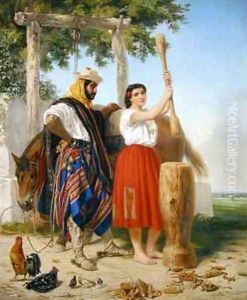Jean-Leon Palliere Paintings
Jean-Léon Pallière was a French-Argentinian painter known for his historical scenes and portraits. Born in Bordeaux, France, on June 26, 1823, Pallière hailed from a family of artists, which included his grandfather, who was an architect, and his father, who was a notable painter. Influenced by his artistic lineage, Pallière developed an interest in art at an early age and pursued his education in the field of painting.
Pallière initially studied under his father, Jean Louis Théodore Pallière, before moving to Paris to further his artistic training. He enrolled in the prestigious École des Beaux-Arts and was a student of Léon Cogniet, a renowned French historical and portrait painter. During his time at the École, Pallière honed his skills and embraced the academic style of painting, which was characterized by its adherence to classical standards and a focus on historical and mythological subjects.
After completing his studies, Pallière traveled to Italy, where he was particularly inspired by the Renaissance masters. His time in Italy had a significant impact on his artistic development and style. In 1850, Pallière relocated to Argentina, following family connections, and quickly became an influential figure within the local art scene. There, he established himself as a portraitist and history painter, receiving commissions from the Argentine elite and institutions.
Pallière's work often reflected his European training, and he is credited with contributing to the introduction of European academic art traditions to Argentina. In addition to his commissions, he created works that depicted key moments in Argentine history, which endeared him to his adopted country. His historical paintings were celebrated for their detailed composition and dramatic storytelling.
Throughout his career, Pallière was an active participant in art exhibitions and received numerous accolades for his contributions to the arts. His paintings are held in several important collections, including museums in Argentina and France. Jean-Léon Pallière passed away on October 4, 1887, in Paris, France. His legacy is remembered for bridging European art with that of South America and for his role in shaping the Argentine art scene in the 19th century.
